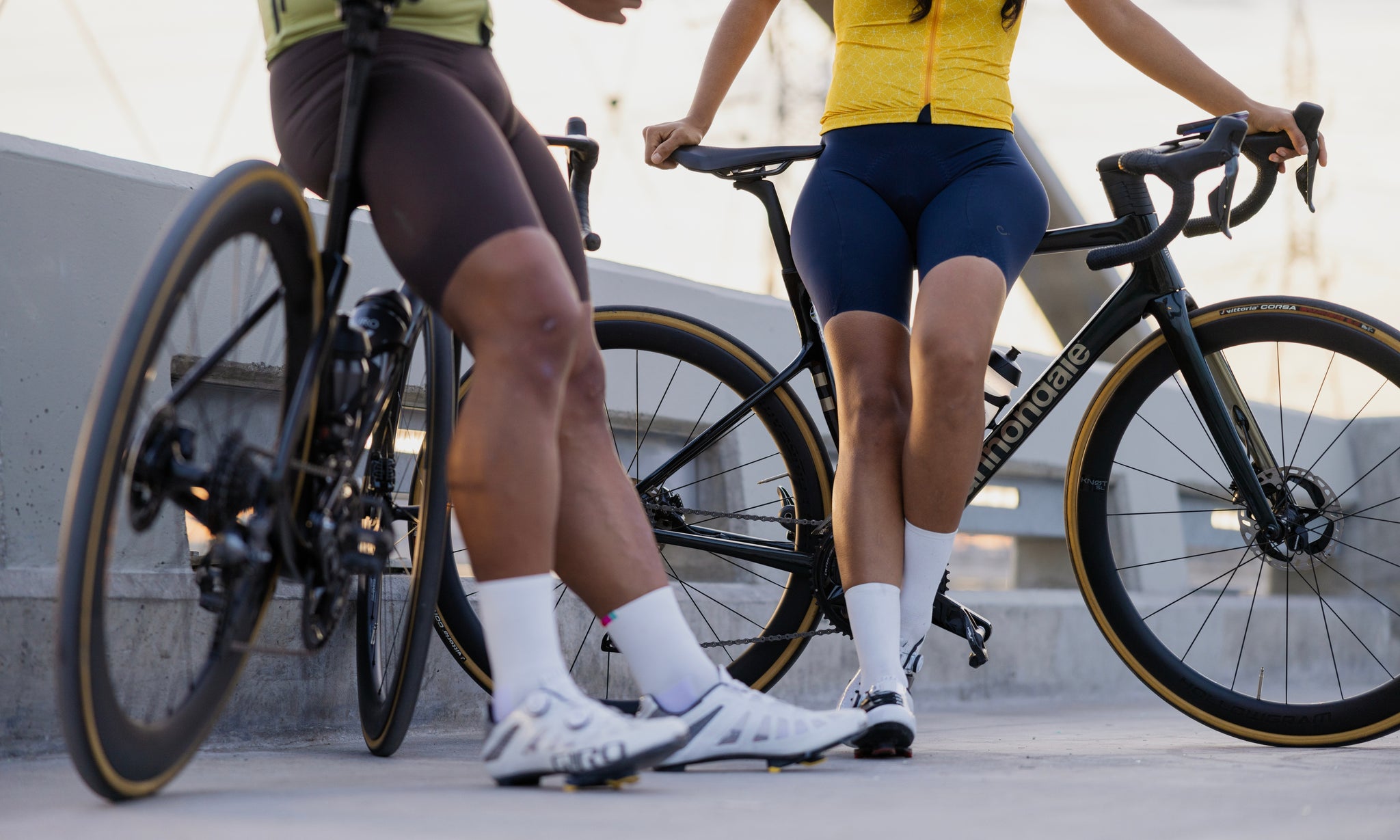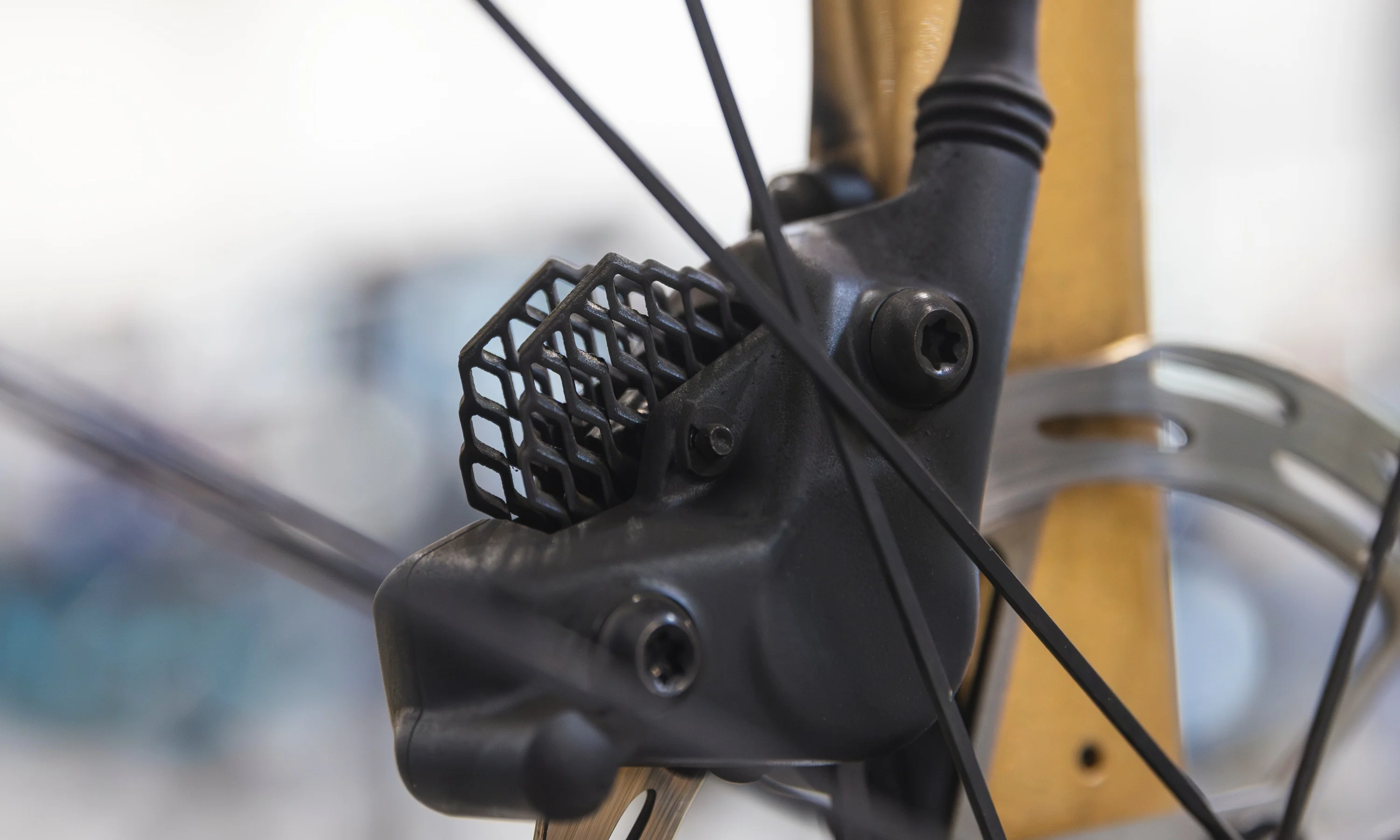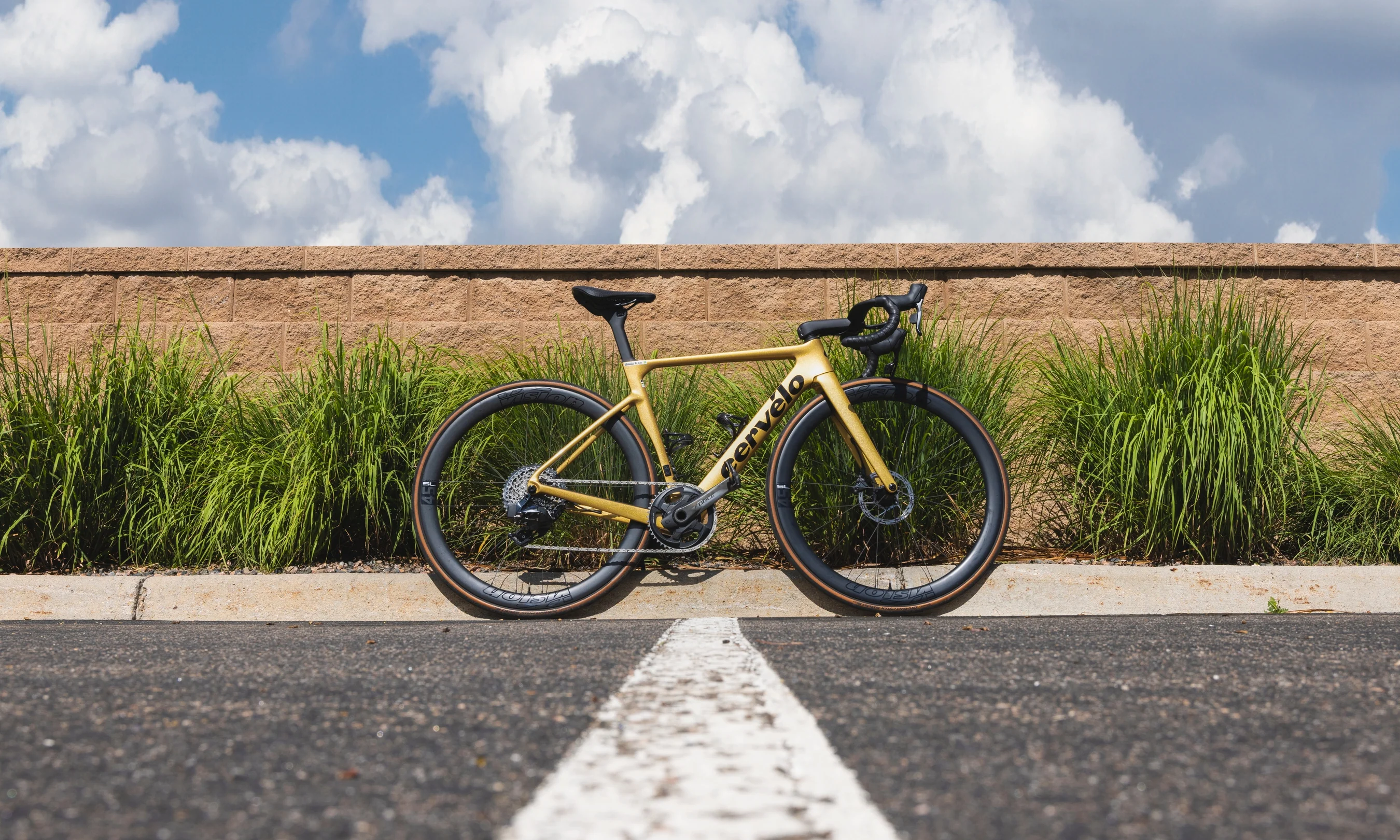For a century, bike tires were all more or less the same. An inflatable tube held air inside of a rubber tire. The clincher system was the most common. If you’re not sure what you’ve used, it’s probably this. The tire's wire or kevlar beads “clinch” inside the wheel's rim, held in place by air pressure and the rim lips. Tubulars, on the other hand, are completely round — the tube is integral to the tire itself. These are glued to the rim without any beads needed.
But with both, pinch flats and punctures have always been annoying issues. So, over the past two decades, a new system has taken the spotlight — tubeless tires.
[button]Shop tubeless tires[/button]
Quick Facts: Clincher vs. Tubeless Tires for Road Bikes
| Clincher (tubed) tires | Tubeless tires | |
| Puncture resistance | Limited to tire construction | Tire construction and sealant |
| Repair options | Replace or patch tube | Sealant, tire plugs, or install a tube |
| Rim compatibility | Universal | Tubeless-compatible rims required |
| General PSI range | 80-120 PSI | 40-100 PSI |
| Rolling resistance | Competitive at higher PSI and w/ specialty tubes | Generally faster at lower PSIs |
| Overall weight* | 324g/wheel | 350g/wheel |
*It will depend on the specific tire. Here, I'm comparing Continental GP 5000 clincher and tubeless tires (28mm width), as an example. Weights are calculated with a Continental Race Light tube for clincher and 60g of tire sealant and a 10g tubeless valve stem for tubeless.
Tubeless tires: The basics

What is a tubeless tire and how do they work?
In 1999, Mavic came up with the first tubeless wheel and tire system for mountain bikes. Over the years, that technology has improved, and now mountain bikes are predominantly tubeless. It's taken a while, but today many road cyclists are starting to opt for tubeless as well. With a tubeless setup, punctures are rarely an issue. Instead of the inner tube, tubeless tires create an airtight seal using a small amount of liquid sealant inside the tires. When the tire is punctured by glass, thorns, rocks, or other debris, the internal pressure pushes the sealant out and seals the puncture almost instantly. Sealant contains natural or synthetic latex, so the seal that’s made when a puncture occurs, closely mimics the tire itself.
[product-block handle="orange-seal-tubeless-tire-sealant-with-twist-lock-applicator-4oz"/]
How to set up tubeless tires
Switching from clinchers to tubeless tires can seem daunting at first. It may require a little more work on the front end, but far less work compared to dealing with flat tires. To start, you’ll need the following:
- Sealant
- Pump (and air compressor/CO2 if necessary)
- Tire levers (if necessary)
- Tubeless valve (if not already included or installed)
- Tubeless tape (if not already included or installed)
- Valve core remover (if necessary)
With tubeless, compatibility is key. A tubeless setup requires tubeless-ready (TLR) or tubeless-compatible wheels and tires. Air is pumped into the tires through a tubeless valve that, when properly installed, produces an airtight seal at the valve hole. Tubeless-ready wheels require a non-porous rim tape (such as Stan’s NoTubes yellow rim tape). This rim strip protection will not absorb sealant and will make the rim air-tight. On most tubeless-ready wheels, the tubeless tape will already be installed.
It’s very important that the rims have been properly taped — if they aren’t, your tires will leak air. Also be sure that tubeless valves are properly installed. A tubeless valve looks similar to and operates the same as a standard Presta valve. But instead of being attached to a tube, there is a rubber base on the valve that produces an airtight seal within the valve hole of the rim. Tubeless valves require a nut that threads onto the body of the valve. This nut tightens the rubber base against the valve hole. It should be finger-tight.
[newsletter]
From there, mounting tubeless tires is very similar to clinchers and can often be done with a floor pump. But, in order to make sure the tire seals, it’s important that the tire beads are set into the rim’s center channel. Sometimes, if a tire isn’t sealing, it will require a strong burst of air from an air compressor or CO2 cartridge. Another trick for stubborn tires is to seat the tire first using a standard tube. Remove the tube but leave one bead fully seated. Then install the tubeless valve and seat the second bead with the pump or compressor. After the tire is seated it can be inflated for everyday use with a floor pump.
You will need to add sealant to your tires by either the direct-pour or the valve-injection method. For direct-pour, simply pour the desired amount of sealant into the tire before inflation/seating. For valve-injection, inflate/seat the tire, then remove the valve core and add sealant through the valve using a sealant injector.
Over time, the tubeless sealant in your tires will dry out and lose its efficacy, so plan on refreshing your sealant every three months. This bit of preventative maintenance will ensure that small punctures will quickly seal when you're out on the road.
The pros of tubeless tires
The comfort of the ride
A tubeless setup is usually lighter than a comparable clincher system because it eliminates the inner tube. This decreases overall bike weight, but more importantly, it decreases rotating weight at the outside of the wheel, improving pedaling and acceleration.
Riders can also run lower air pressure in tubeless tires compared to clincher tires because they don't have to worry about pinch flats as much. Pinch flats occur when the inner tube is compressed between the tire and rim during a hard impact. On loose or rough surfaces, you'll have more confidence, grip, and speed with lower tire pressures. Tires conform better to the terrain when they're at lower pressures. This can even reduce rolling resistance on rough surfaces. Experiment with tire pressures to find your ideal set-up.
[product-block handle="enve-ses-road-tire-700x29c-tubeless-tan"/]
There’s less chance of flats
Because sealant takes care of minor punctures, flat tires are far less likely. Though tubeless systems are effective and reliable, they are not invincible. There’s a limit to what tubeless sealant can seal (Stan’s NoTubes tire sealant claims to repair holes up to ¼”), so sealant is not effective in all situations. Whether you’re on a mountain bike, gravel bike, or road bike, it’s alway best to carry a flat repair kit that includes a traditional inner tube, in case a puncture occurs on a sidewall and cannot be sealed with sealant or a tire plug.
It’s also still possible to pinch-flat a tubeless tire if an impact is hard enough to cut the tire itself. If you are bottoming out the tire against the rim often, your tire pressure is likely too low.
[product-block handle="wolf-tooth-encase-system-chain-tire-plug-multitool"/]
Rolling resistance
Rolling resistance has to do with inertia and will influence acceleration and maintaining speed. As you’d expect, less rolling resistance is faster, and is almost always better! Rolling resistance on road tubeless tires is lower than that of both clinchers and tubulars because the friction between the inner tube and the casing is eliminated.
The cons of tubeless tires
Difficulty of installation
Installing tubeless tires requires patience and can be a bit messy the first time around, but with experience, it gets easier. It’s true that you need to get everything — the rim tape, the sealant, the valve — just perfect. And that can be frustrating at first. But if you take it slow, and make sure that everything is installed correctly, the rewards are worth the effort. One way to minimize mess is by injecting sealant through your valve. Tubeless valves have removable cores to make this easy.
Tubeless tires come with a higher cost
A tubeless setup does come with costs. You need a TLR wheelset and tires, which is an investment. Buying new wheels and new tires just to shave off some weight and avoid changing so many flat tires might not seem worth the money to some. But once you’ve got a tubeless setup in place, most say that it’s far less maintenance. If you’re looking to buy a new bike, keep an eye out for models that come equipped with tubeless ready wheels.
[button]Shop tubeless road wheels[/button]
Valve core clogs
Unlike clinchers and tubulars, tubeless tires require valve core maintenance. Because the sealant gets in and around your valve, it can sometimes get sticky and clog, which makes it difficult to add air and maintain desired air pressure. Generally, you should clean your valve core anytime you add sealant.
You need tubeless-ready rims
In order to be tubeless-ready, the rim needs a center channel for easy setup, and the rim walls need to be designed specifically to hold tubeless tire beads. Rims need to have the spoke beds sealed with rim tape. Again, an investment on the front end, with rewards down the road.
How to know which kind of tire is right for you
Where you ride
Choosing the right tubeless tire setup depends largely on where you ride. Bike paths, city streets, gravel roads? Some tubeless tires are made for speed on pavement and some are made for lower tire pressure and/or durability.
The Schwalbe Pro One tire makes tubeless road tire top-10 lists because it’s both lightweight and offers a puncture protection belt to make the tire less vulnerable. The Continental Grand Prix 5000 TL offers low rolling resistance and great grip, but is slightly heavier than other tubeless road tires. The Bontrager R3 Hard-Case Lite TLR tires roll fast, grip well, and despite being 32mm, they’re incredibly light. The WTB Exposure comes in both 700c x 30mm and 36mm sizes. They’re great for smooth tarmac, and not so smooth tarmac. The Hutchinson Sector is also good for the rough stuff and comes in 28mm and 32mm, depending how plush you want your tires to feel. And then there’s the WTB Horizon, which comes in at 47mm wide, great for even the roughest road commute.
Know your budget
Tubeless road tires range in price from about $40 to $100, so it’s important to assess what kind of riding you’re doing, and what you really need out of a tire. If you’re not racing the Tour de France, you likely don’t need to buy the absolute lightest tires with the lowest rolling resistance. And if you’re not taking on intense gravel, you probably don’t need adventure-ready treads.
Conclusion: Are tubeless road bike tires worth it?
People have been using clinchers and tubulars for over 100 years, so why stop now? After all, tubeless tires aren’t 100% guaranteed to keep you from a flat tire. But, tubeless road bike tires offer greater puncture protection, they’re lighter weight, and offer a lower rolling resistance, which results in a more comfortable, more controlled ride. While those on mountain bikes and gravel bikes flocked to tubeless tires years ago, many on road bikes are also seeing the benefits of fewer flats, lower pressures, and a better overall riding experience.
We meticulously (and independently) pick every product, and if you purchase through our links we may earn a commission.













